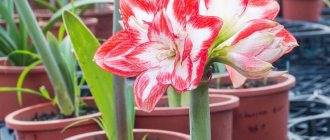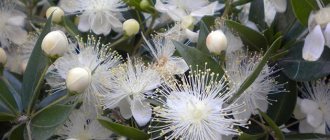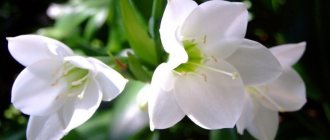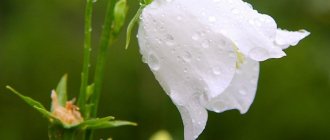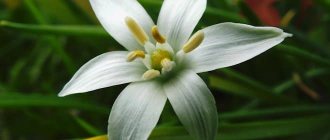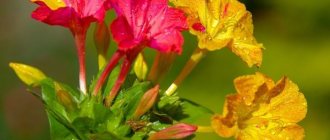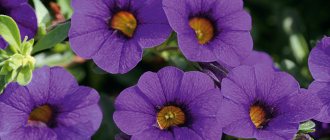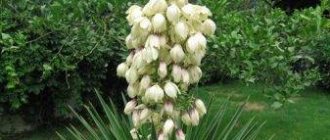The Strelitzia plant, also called Strelitzia, is the type genus of the Strelitzia family. This genus includes 4 species that are naturally found in Madagascar and South Africa. This plant got its name in honor of the wife of King George III, Queen of Great Britain, Charlotte Sophia of Mecklenburg-Strelitz. At the same time, one of the species was named Strelitzia royal, and the other - Strelitzia Nicholas in honor of the autocrat of the All-Russian Nicholas I. People call this plant “bird of paradise”, this name is associated with the unusually beautiful flowers of this plant.
Brief description of cultivation
- Bloom . In spring for 6 weeks.
- Illumination . Diffused but bright light is needed, so it is best to choose an eastern or western window sill.
- Temperature regime . During intensive growth, the plant feels good at normal room temperature. In winter, the room should be colder than 14 degrees.
- Watering . During the growing season, it is necessary to water frequently, but moderately, and the soil mixture in the pot should always be slightly moist. In winter, watering is carried out approximately once every 1.5 weeks.
- Air humidity . It should be elevated. On hot days, moisten the foliage with a spray bottle.
- Fertilizer . During the growing season and during flowering, the bush is fed regularly once every 10 days, for this purpose mineral fertilizers and organic matter are alternately used.
- Quiet period . Conditional, in winter.
- Transplant . While the bush is young, it is replanted once a year, and older plants - once every 3 or 4 years.
- Reproduction . Seeds (must be freshly collected), side shoots and parts of those bushes that are already 6 or 7 years old.
- Harmful insects . Scale insects, mealybugs, aphids and spider mites.
- Diseases . This plant is highly resistant to disease. However, due to regular waterlogging of the soil mixture in the pot, the root system may rot.
Feeding frequency
During active growth, Strelitzia needs regular feeding. For this purpose, organic and mineral compositions of complex fertilizers are used. The dosage selection is calculated based on the age of the flower and its characteristics. On the back of the package, as a rule, there are detailed instructions for using mineral products.
Between September and December, the addition of nutrients is stopped. At this time, the plant begins a dormant period. The addition of any nutritional compounds will not bring the desired result, but on the contrary, it can reduce the rate of formation of flower stalks and shorten the flowering period.
Features of Strelitzia
In natural conditions, Strelitzia is a herbaceous evergreen perennial plant. The height of the largest specimens in the wild can reach more than 10 m, and the average size of the bushes is 2–3.5 m. The core root system extends into the deep layers of the soil. The oval, large, leathery green leaf plates have a bluish-gray coating on the surface. The leaves can reach 0.1–0.8 m in width and 0.3–2 m in length; in appearance they are very similar to banana foliage, but their petioles are longer—0.5–0.9 m. On a long The peduncle contains a horizontal inflorescence, which is similar in appearance to the crest of a fancy bird; it consists of purple or orange flowers that reach 10–20 centimeters in diameter. There can be 5–7 flowers on one peduncle, while 6 peduncles and even more are formed on one bush; therefore, the plant can bloom for up to 6 months.
If you take good care of your home Strelitzia, it will delight you with its long, lush flowering several times a year. When cut, the flowers of this plant last a relatively long time - from 15 to 30 days.
Strelitzia Nikolai, history of the plant. Replanting in pots with automatic watering in the ground for Strelitzia
Landing
Planting Strelitzia is in fact no different from planting other plants. But it is worth remembering the fragile roots and acting carefully.
Choosing a pot
Strelitzia is a tall plant with tap roots, so tall, not wide containers are suitable for planting it. There must be drainage holes in the bottom, since the crop reacts negatively to stagnation of moisture at the roots.
It should also be taken into account that a tall crop can outweigh the container, so for adult specimens it is better to choose heavy and stable pots.
Soil composition
Strelitzia is an undemanding crop and grows well in any fertile soil. You can buy a ready-made mixture in the store or prepare it yourself. The main thing is that the mixture is loose and allows moisture to pass through. Typically, gardeners use mixtures of sand, peat, turf and leaf soil. A little coal is added to the finished composition.
Transfer
Recommended by topic
How to deal with mealybugs on indoor plants Lighting for indoor plants: installation and use of lamps, types of phytolamps, lack or excess of light Pruning house flowers: types, tools, care
Plants up to three years old are replanted annually, and older specimens every 3–4 years. Young and adult bushes are transplanted using the transshipment method so as not to injure the roots.
Before transplanting, water the bush thoroughly so that the earthen lump does not crumble. Then remove the plant from the pot and transfer it to a new one.
If Strelitzia has problems with roots, then the old soil is removed and all diseased areas are cut out. Dry the cut areas a little, sprinkle with charcoal or burn with brilliant green. If cleaning of the roots is required, the plant is not watered, but rather dried for a week.
Drainage is poured into the bottom of the pot, then some fertile soil. Place the bush in the center and sprinkle it on all sides with a nutrient mixture. Tamp down a little and water well.
Strelitzia care at home
Illumination
It is quite easy to grow Strelitzia at home, as it is distinguished by its unpretentiousness and low maintenance requirements. Since it grows best under bright, diffused lighting, it is recommended to place it on a western or eastern window. Do not allow the bush to be exposed to direct sunlight.
Temperature
This plant is heat-loving, but during the dormant period in winter it should be kept cool (no higher than 14 degrees). At other times of the year, it grows well and develops at temperatures typical for residential premises. In the warm season, if possible, it is recommended to move the Strelitzia outdoors (to the garden or to the balcony), but you should choose a place for it that will be reliably protected from gusts of wind and direct sunlight.
Watering
During the spring-summer period, watering should be moderate but frequent. Make sure that the soil mixture in the container is slightly moistened at all times. But do not overdo it with watering, as systematic stagnation of liquid in the root system can harm the plant. In winter, watering is carried out approximately once every 10 days. For irrigation, you should use filtered or well-settled water, the temperature of which is close to room temperature.
Air humidity
In indoor conditions, such a plant needs slightly increased air humidity. In this regard, on hot days, the leaf plates should be wiped with a damp sponge or sprayed with a spray bottle.
Top dressing
Domestic strelitzia is fed during flowering and during the growing season once every 1.5 weeks. For this purpose, both mineral fertilizers and organic matter are used, and they should be added to the substrate alternately. After flowering ends, the plant is not fed for 2–3 months, while there is a dormant period. Before moving the bush to a cool room where it can rest well, all its flower stalks are cut off.
Strelitzia transplant
If young bushes are replanted regularly once a year in the spring, this will have a positive effect on their development. Adult bushes undergo this procedure only once every 3 or 4 years, because their roots are very fragile and can easily break during transplantation.
However, some gardeners have learned to replant Strelitzia in such a way that its root system is not stressed. To do this, first prepare a special loose and nutritious soil mixture: combine sand, peat, humus, leaf and turf soil (taken in equal parts). The container for planting is taken high and a thick drainage layer is made at its bottom; it is sprinkled with a layer of prepared substrate. Then carefully transfer the healthy bush into a new pot and slowly fill all the voids with fresh soil mixture, which is compacted regularly. If the bush has problems with roots, then first remove it from the old pot and carefully remove all the old substrate. After this, carefully inspect the root system and cut out all diseased areas, and then sprinkle the cut areas with charcoal powder. Next, the bush is planted in a new container.
Transplantation
